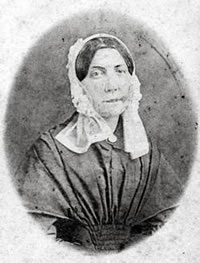S.C. Encyclopedia | Maria Martin was born in Charleston on July 6, 1796, the youngest daughter of John Jacob Martin and Rebecca Solars. While no records of her formal schooling have been discovered, it is known that she was well read in literature, French, and German and possessed an interest in music, art, and natural science. By 1827 she and her mother had moved into the home of her brother-in-law, the Lutheran minister and naturalist John Bachman, and her ailing sister Harriet. Martin helped to raise and educate her sister’s fourteen children and manage the household.

Martin
A devoted and pioneering American naturalist, Bachman encouraged Martin’s early interest in natural science and botany. The focus of both of their lives changed when the artist and ornithologist John James Audubon arrived in Charleston in 1831 and began a lifelong friendship and association with them, forged by the later marriage of Audubon’s sons to two of Bachman’s daughters.
Martin had already rendered sophisticated botanical sketches. Recognizing her talent, Audubon introduced her to his painting techniques, materials, and methods of posing birds, which she absorbed enthusiastically. The following year he began asking her to prepare botanical backgrounds for his work The Birds of America. Drawing specimens from Bachman’s extensive garden at her own home and from the gardens of such noted Charleston horticulturists as Philippe Noissette and Joel Poinsett, she contributed numerous native plant illustrations and related studies for plates in volumes 2 and 4, such as the rare franklinia for Bachman’s warbler and the azaleas and butterflies accompanying Swainson’s warbler. In intensive, collaborative work during the 1830s, Audubon commonly painted the birds, and Martin would finish the composition with detailed natural settings or simple habitats. At times he requested that she portray specific botanical elements, such as insects or branches, which were incorporated into the original bird paintings at the London printer by his son Victor.
In response to Audubon’s and Bachman’s need for fine botanical drawings, Martin made an intensive study of insects, copying both text and illustrations of Thomas Say’s American Entomology (1824–1828). This copy and related sketches are in the Charleston Museum’s collection, while several other examples of Martin’s art are at the New-York Historical Society. Audubon acknowledged her work and talent several times in his Ornithological Biography (1830–1839) and named a bird species, Picus martinae (Maria’s Woodpecker), in her honor. In the mid-1830s she produced several sketches for John Holbrook’s North American Herpetology (1836–1842), although only the image of the black racer snake was attributed to her. Her collaborations with these influential naturalists have made her one of the most important American natural-history artists of the nineteenth century.
Martin often assisted Bachman in his published writings on natural science and religion, and during the production of Audubon’s Viviparous Quadrupeds of North America (1845–1853), she worked as an editor of the text. Two years after her sister’s death, she married Bachman on December 28, 1848. With occasional travel, they remained in their home surrounded by family until 1862, when they left Charleston and took refuge in Columbia. Martin died there on December 27, 1863, and was buried in the Ebenezer Church cemetery.
— Excerpted from an entry by Roberta Kefalos Sokolitz. This entry hasn’t been updated since 2006. To read more about this or 2,000 other entries about South Carolina, check out The South Carolina Encyclopedia, published in 2006 by USC Press. (Information used by permission.)



 We Can Do Better, South Carolina!
We Can Do Better, South Carolina!
























